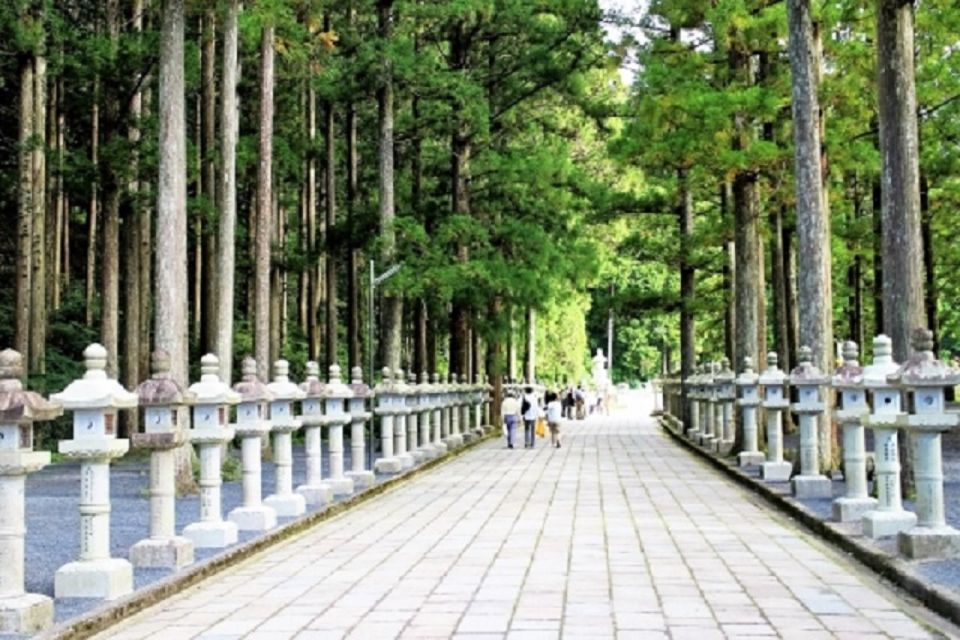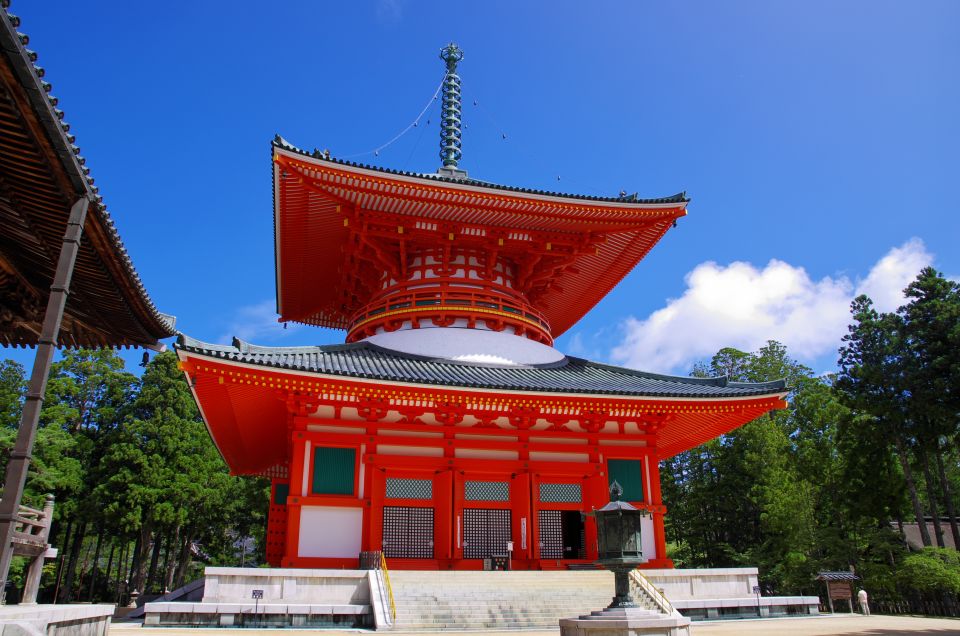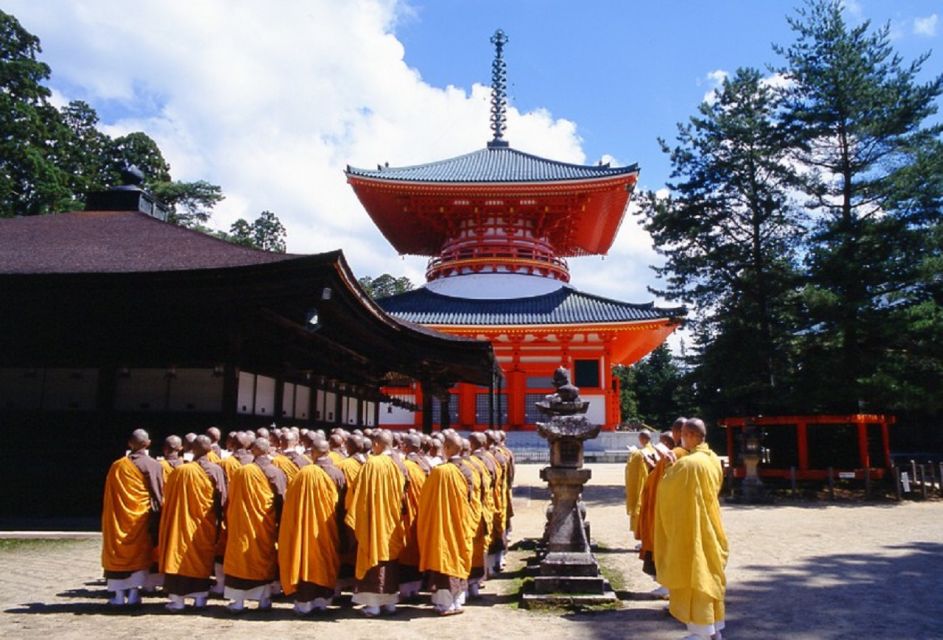Nestled deep within Japan’s sacred landscapes, Mount Koya beckons travelers to embark on a captivating journey through its rich spiritual heritage. Tracing the footsteps of the revered monk Kukai, this guided private walking tour offers an immersive exploration of the Shingon Buddhist sect‘s timeless serenity. From the ornate interiors of Kongobuji Temple to the iconic Daoto pagoda, each step reveals the intriguing history that has shaped this UNESCO World Heritage site. Join experienced guides as they unravel the profound impact of Shingon Buddhism, leaving you with a deeper understanding of Japan’s most sacred landscapes.
Key Points

- The Mt. Koya Guided Private Walking Day Tour offers a guided exploration of the ancient Buddhist haven of Mount Koya, a UNESCO World Heritage site.
- The tour includes visits to the Kongobuji Temple, the head temple of the Shingon sect, and the Danjo Garan Complex, featuring pagodas and halls.
- The tour provides insights into the profound influence of Shingon Buddhism on the sacred landscapes of Mount Koya, founded by the revered monk Kukai in the 9th century.
- The tour is a 6.5-hour guided walking experience, with entrance fees to the key attractions and an English-speaking guide included.
- The tour may not be suitable for pregnant women, wheelchair users, or those with high blood pressure due to extended walking and uneven terrain.
Exploring Mount Koya’s Rich History

The ancient Buddhist haven of Mount Koya, a UNESCO World Heritage site, beckons visitors to uncover its centuries-old spiritual legacy.
Founded in 816 AD by the revered monk Kukai, this secluded mountain retreat has long been a center of Shingon Buddhism, one of Japan’s major Buddhist sects.
Strolling through the atmospheric streets, you’ll encounter historic temples, towering cedars, and the hallowed Okunoin cemetery, home to the mausoleum of Kukai himself.
As your knowledgeable guide shares insights into this sacred landscape, you’ll gain a deeper appreciation for the profound influence of Buddhism on Japanese culture and spirituality.
Each step reveals new layers of Koyasan’s captivating history, inviting you to learn about its timeless serenity.
You can also read our reviews of more walking tours in Wakayama Prefecture
Visiting Kongobuji and Danjo Garan

As visitors explore the historic grounds of Mount Koya, they’ll encounter two of its most renowned temples – Kongobuji and Danjo Garan.
Kongobuji, the head temple of the Shingon sect, impresses with its ornate interiors and stunning landscape garden, where carefully curated pine trees and moss-covered rocks create a serene, meditative ambiance.
The Danjo Garan complex showcases an array of pagodas and halls that embody the architectural beauty of traditional Japanese Buddhism. Towering above the complex is the iconic 49-meter-tall Daoto pagoda, its golden-hued roof glistening in the sunlight.
Experienced guides provide insights into the significance and history of these sacred sites, inviting visitors to enjoy the spiritual essence of Mount Koya.
Understanding Shingon Buddhism’s Impact

Shingon Buddhism’s profound influence permeates the sacred landscapes of Mount Koya, shaping its spiritual identity and architectural marvels over centuries.
Founded by the revered monk Kukai in the 9th century, this esoteric sect has left an indelible mark on the region.
Visitors can witness the sublime fusion of nature and spirituality, where towering cedar trees shelter centuries-old temples and meditation halls.
The intricate symbolism and rituals of Shingon Buddhism are woven into the very fabric of Koyasan, from the ornate sculptures adorning the halls to the chanting of sutras that echoes through the air.
Immersing oneself in this hallowed ground offers a profound connection to Japan’s rich religious heritage and the enduring wisdom of Shingon.
Logistical Details and Inclusions

Booking the private guided walking tour of Mount Koya unlocks a wealth of logistical details and inclusions that enhance the experience. The 6.5-hour excursion commences at Koyasan Station, where an English-speaking guide ushers participants through the historic site. Entrance fees to the sacred Kongobuji temple and Danjo Garan complex are covered, allowing seamless access to these architectural marvels. Complimentary bottled water keeps visitors hydrated as they enjoy the profound teachings of Shingon Buddhism.
| Inclusions | Exclusions |
|---|---|
| Entrance fees for Kongobuji and Danjo Garan | Lunch (can be purchased during the tour) |
| English-speaking guide | Not suitable for pregnant women, wheelchair users, or people with high blood pressure |
| Bottled water | – |
| – | – |
The tour’s flexible cancelation policy and reserve now, pay later option further enhance the convenience and accessibility for travelers.
More Great Tours NearbyHighlights of the Walking Tour
Visitors embark on a captivating journey through the historic grounds of Mount Koya, a UNESCO World Heritage site and renowned Buddhist pilgrimage destination.
They’ll wander the serene paths, discovering the sacred Kongobuji temple and the awe-inspiring Danjo Garan complex, all the while learning about the rich Shingon Buddhist heritage from an experienced local guide.
At Kongobuji, they’ll be amazed by the exquisite fusuma-e paintings and the massive gate that symbolizes the connection between heaven and earth.
The Danjo Garan, a collection of iconic temples and pagodas, offers a glimpse into the deep spiritual traditions that have flourished here for centuries.
Throughout the tour, guests are immersed in the profound stillness and tranquility that permeates this sacred mountain.
You can also read our reviews of more guided tours in Wakayama Prefecture
- Mt. Koya Sacred Half-Day Private Tour With Government Licensed Guide
- Koyasan Self-Guided Route App With Multi-Language Audioguide
- Kumano Kodo Pilgrimage Full-Day Private Trip With Government Licensed Guide
- Kumano Kodo Pilgrimage Tour With Licensed Guide & Vehicle
- Mt. Koya Sacred 6hr Private Tour With Government Licensed Guide
- Tuna Auction Market Guided Private Tour in Nachi-Katsuura
Considerations for Certain Travelers
Despite the serene beauty of Mount Koya, the walking tour may not be suitable for all travelers. Pregnant women, wheelchair users, and those with high blood pressure should exercise caution, as the uneven terrain and extended duration could pose challenges.
The tour involves navigating through historic temples and shrines, which may require traversing steep steps and narrow pathways. Those with mobility or health concerns may find the physical demands of the tour overwhelming.
The tour operator advises consulting a healthcare professional before booking, to ensure the tour aligns with individual abilities and needs. Participants must be willing and able to engage in extended periods of walking to fully appreciate the remarkable sights and spiritual atmosphere of this UNESCO World Heritage site.
Booking and Cancellation Policy
When it comes to booking the Mount Koya walking tour, travelers can reserve their spot now and pay later. The tour operator offers a free cancellation policy up to 24 hours in advance, providing flexibility for those with unpredictable schedules.
This allows visitors to secure their spot without the immediate need to pay, and the option to cancel if plans change. The booking process is straightforward and convenient:
- Tour duration is 6.5 hours, starting from Koyasan Station
- Reservations can be made online or over the phone
- Payment isn’t required until the day of the tour
- Cancellations are free up to 24 hours prior to the tour
- Participants can take advantage of the ‘reserve now, pay later’ option
Meeting Point and Duration
The tour kicks off at Koyasan Station, the starting point for the 6.5-hour exploration of Mount Koya’s sacred grounds.
This UNESCO World Heritage site is a renowned Buddhist pilgrimage destination, and visitors will explore its rich history and spiritual significance with the guidance of an experienced local expert.
The day’s journey promises to be both enlightening and immersive, as participants weave through the historic Mt. Koya site, visiting revered temples like Kongobuji and Okunoin.
Along the way, they’ll gain invaluable insights into Shingon Buddhism and its deep roots in Japan.
With entrance fees and bottled water included, travelers can focus on soaking up the serene atmosphere of this hallowed mountain retreat.
Frequently Asked Questions
Can I Bring My Pet on the Tour?
Unfortunately, pets are not permitted on the private guided walking tour of the historic Mount Koya site. The tour focuses on exploring sacred temples and learning about Shingon Buddhism, which has specific guidelines regarding animal visitors in these revered spaces.
What Is the Dress Code for the Tour?
The dress code for the tour is respectful and modest. Visitors should avoid shorts, sleeveless tops, and other revealing attire as they’ll be exploring sacred Buddhist temples. Comfortable walking shoes are a must for navigating the historic site.
Is There a Discount for Students or Seniors?
The tour does not offer any discounts for students or seniors. The fixed price applies to all participants regardless of age or student status. However, the tour may provide concessions for special circumstances upon prior arrangement.
Can I Customize the Tour to Fit My Interests?
Absolutely! The tour is highly customizable to meet your specific interests. Simply communicate your preferences to the knowledgeable guide, who’ll tailor the experience to focus on the aspects of Koyasan that most intrigue you.
How Many People Are Typically in a Tour Group?
Group sizes typically range from 2 to 6 people on these private guided tours, allowing for a more intimate and customized experience. The small group size facilitates engaging discussions with the knowledgeable local guide.
Recap
Immerse oneself in the captivating history and timeless serenity of Koyasan, a UNESCO World Heritage site where the Shingon Buddhist tradition thrives.
Witness the ornate beauty of Kongobuji Temple, the iconic Daoto pagoda, and the Danjo Garan complex, all while gaining insights from experienced guides.
This private walking tour offers a profound exploration of Japan’s sacred landscapes, leaving visitors with a deeper understanding of the region’s remarkable spiritual heritage.
You can check availability for your dates here:More Walking Tours in Wakayama Prefecture
More Tours in Wakayama Prefecture
More Tour Reviews in Wakayama Prefecture
Not for you? Here's more nearby things to do in Wakayama Prefecture we have reviewed
- 7 Hours Tour Enjoyment Light Plan in Koyasan
- Private Tour at the Sacred Sites in Koyasan
- Tuna Auction Market Guided Private Tour in Nachi-Katsuura
- Kumanokodo 1 Day Walking Tour
- Private Half- Day Tour in Wakayama Koyasan
- Mt. Koya Sacred 6hr Private Tour With Government Licensed Guide
- Kumano Kodo Half Day Daimonzaka and Nachi Taisha Tour
- Kumano Kodo Pilgrimage Tour With Licensed Guide & Vehicle
- Private 2-Hour Koyasan Highlights Tour – UNESCO Heritage
- Kumano Kodo Pilgrimage Full-Day Private Trip With Government Licensed Guide
- 2 Best Guided Tours In Wakayama Prefecture
- 3 Best Private Tours In Wakayama Prefecture
